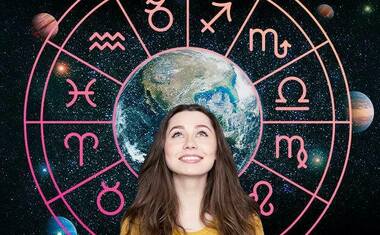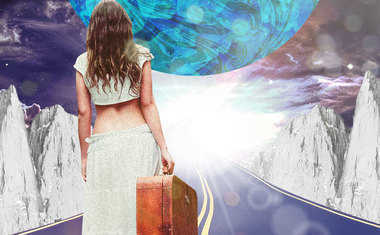
Defining Magic
So just what is 'magic'?
4. Defining magic
The Church condemned magic. But what exactly was magic? The Church's position reminds one of the judge who declared that he couldn't define pornography but he knew it when he saw it. If one wished to preserve the cult of saints who performed miracles while damning the magician for almost identical acts, then one had to be extremely cautious and precise in defining exactly what was condemned and what was accepted. The dilemma was faced by drawing a set of fine distinctions concerning what was miraculous and what was illicit magic. Without claiming to be definitive, the following distinctions and criteria seem to be primary in determining what was condemned and what was accepted.
Necromancy or black magic
The first distinction is clear. Any action or ritual designed to summon demons was forbidden. The Church never wavered on this point. It didn't matter if the ritual used liturgical prayers, if it was designed to summon demons, it was condemned.
Compelling vs. beseeching
A second distinction is also clear. Man is subject to spiritual powers rather than being the master. Therefore, it is proper for man to pray, beseeching angels or saints for assistance. It is never proper to perform a ritual designed to compel or force spiritual power, such as demons, to act (Peters 1978). Even if the ritual seemed innocent, there was always the possibility that demons are involved in compelling (Ankarloo and Clark 2002). Indeed, if a ritual designed to compel actually worked, it was probably through the agency of demons who were deceiving the magician into doing evil.
Content of ritual
As a third criterion, the magical act cannot contain forbidden elements. Thus, one could light a candle and kneel before the image of a saint but the identical actions before an idol or unapproved effigy were forbidden. Incantations drawn from scripture and liturgy were allowed but prayers or names drawn from a mysterious language, often claimed to be Chaldean, might caused the ritual to be condemned. Another way to look at this criterion is that the means employed in the ritual must be legitimate.
Purpose
The fourth criterion relates to the purpose for which the ritual is performed. Thus, astrology and astrological images could be used to cure disease but not to harm an enemy. Indeed, astrological image magic, incantations, and the magical properties of herbs and gems were an integral part of medieval medicine (Biedermann 1986) and were required curricula in the university medical schools. Similarly, divination to warn of storms or plague was usually approved, but divination to tell an individual�s fortune was disapproved as frivolous and dangerous.
Source
The fifth criterion deals with the source of the ritual or the text from which it is taken. Texts believed to be authored by Solomon or Hermes Trismagistus were often accepted as authoritative. Texts or rituals of unknown origin were suspect. This largely explains the tendency of many authors to attribute their magical texts to acceptable sources. Note that the source need not be scriptural or Christian. The Chaldean oracles, the Sibylline books, and the Hermetic writings were also acceptable.
Ignorance vs. knowledge
The sixth distinction is clear in medieval writers who reject magic because it is based on fraud and ignorance. Roger Bacon, for example, largely rejected magic because it was based on the credulity and ignorance of the magician (Thorndike 1923). The magician didn't control or compel the demons, rather the demons pretended to be compelled in order to encourage the evil intent of the magician and cause him to commit evil.
In the third quarter of 14th century, Nicholas Oresme argued that most magic was illusionary, simply imagination and abnormal brain function due to fasting, staring to mirrors, etc. (Thorndike 1934). Many medieval and Renaissance authors acknowledged that astrology was a science but warned against diviners who used astrology because they were almost always too ignorant to understand how to apply the science properly. Engelbert of Admont condemned divination not because it was untrue or intrinsically evil, but because it was unsafe in the hands of the ignorant (Thorndike 1934). The authorities also forbade many practices viewed by the common people as magic but seen by the Church as ignorant superstition.
The distinction drawn by the medieval authorities is sometimes hard to appreciate because they often accepted as established facts what we now know are errors. Nicholas Oresme, for example, believed that a basilisk can kill a man by its glance though basilisks never actually existed. He also maintained that some men have gone without food for 20 years (Thorndike 1934). Engelbert of Admont discusses the ability of the lynx (a non-existent beast, not the wildcat) to see through walls! Many authorities discussed the proper time of the month to bleed a patient. Pier andido Decembrio, secretary to Duke of Milan in 1447, discussed dipping dirty wool in the milk of a donkey and binding it over navel as an aid to conception. The eyes of certain women can poison air and kill children, even without the aid of demons. Hairs of women, buried in fertile ground, generate serpents. Henry of Hesse (1325-1397) discusses the spontaneous generation of mice from putrefaction (Thorndike 1934). He also argues at some length that women should be given higher status in society since they are almost completely human!
Magic vs. science
The "science" or body of established knowledge in the early 15th century obviously incorporated many errors. Nevertheless, this distinction between licit and illicit knowledge was based, in their minds, on firm theological foundations. God had placed many secrets in nature that can be discovered by man's reasoning powers or by mystical experience and these hidden properties were meant to be discovered and used. Thus, while condemning some forms of magic, they tried to save legitimate uses of it, primarily for medicine and judicious future planning (Flint 1991).
What the modern reader must bear in mind is that at the time of the Tarot's invention the same Greek and Latin words (e.g., disciplina) were used to cover knowledge of poisons, sorcery, incantations, and herbal drugs (Thorndike 1934). At that time, magic texts included such things as the manufacture of dyes, optics, and cryptography (Couliano 1987). The medical student studied both anatomy and formulas using serpent's horn. The physician needed to know the planetary influences that affected diseases in order to know the proper times to prepare and administer medicines (Kieckhefer 1989). So when one reads that the Church condemned magic, that doesn't necessarily include astrology, image magic, or divination.
Even without the Neoplatonic theology and cosmology that underlay most of their worldview, it was clear to them that planets affected events on earth: the sun provided warmth and plant growth and the moon controlled the tides and menstrual cycles. So we should not be surprised to learn that diviners were consulted to read dreams and foretell favorable times for action. Such diviners were often employed at noble courts, including the papal court (Kieckhefer 1989).
Similarly, natural objects had occult properties and their use was encouraged. Thus, extract of opium poppy could be used to control epilepsy. Engelbert of Admont demonstrated the occult properties of natural objects with the example of the magical magnetic properties of iron (Thorndike 1934). Surely, one could not condemn the application of this natural magical property in the compass!
Thus, there is a licit branch of magic that takes advantage the occult properties of stones, plants, objects. The only caveat is that their use must satisfy all the criteria given above. The occult properties of plants can be used to cure, but not to poison. One may beseech the saints to increase the potency of an herb, but not perform incantations to demons who could also ensure success of the medicine.
Similarly, there is a licit branch of divination that warns authorities of plague or disasters. But fortune-telling was frowned upon as potentially influenced by clandestine demons and potentially violating the doctrine of free will.
Studying vs. practicing magic
There is a final distinction that played little part in condemning magic but is important for understanding how magical knowledge was communicated to the 15th century. The distinction is that is that it was illicit to practice magic or perform forbidden rituals but theologians and the learned were encouraged to study magic in considerable detail.
The reason for this distinction is simple. The Church never tried to suppress magic in general because some forms of magic were considered both licit and important. However, distinguishing between the licit and illicit was the tricky bit. Canon lawyers, theologians, and inquisitors had to be thoroughly familiar with the material in order to determine what was to be encouraged and what was dangerous and what was to be suppressed. Thadeus of Parma (1318) cites Aristotle as saying that "knowledge of evils is a good thing because evil cannot be avoided unless it is known" (Thorndike 1934). The result was that even the darkest texts of black magic were not destroyed. Instead, they were forbidden to the laity and carefully preserved in the monasteries.



